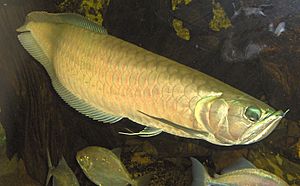Osteoglossiformes facts for kids
Quick facts for kids Osteoglossiformes |
|
|---|---|
 |
|
| Osteoglossum bicirrhosum | |
| Scientific classification |
|
| Kingdom: | Animalia |
| Phylum: | Chordata |
| Class: | Actinopterygii |
| Superorder: | Osteoglossomorpha |
| Order: | Osteoglossiformes L. S. Berg, 1940 |
| Families | |
|
|
| Synonyms | |
|
|
Osteoglossiformes are a group of fish often called "bony tongues." This name comes from the Greek words for "bone" and "tongue." They are a very old group of ray-finned fish. All 245 known living species of these fish live in freshwater. You can find them in South America, Africa, Australia, and southern Asia. They first appeared when the ancient supercontinent Gondwana was still together.
Contents
Amazing Features of Osteoglossiformes
These fish have some really cool and unique features. One of the most interesting is their gastrointestinal tract. Unlike almost all other fish, the front part of their digestive system goes to the left of their esophagus and stomach. In other fish, it goes to the right!
Electric Fish in This Group
Some members of the Osteoglossiformes order are known as weakly electric fish. This means they can create and sense weak electric fields. The Gymnarchidae family, which includes the African knifefish (Gymnarchus niloticus), and the Mormyridae family, known as elephantfishes, are examples. They use these electric fields to find their prey in dark or murky waters. It's like having a built-in radar system!
Their Unique Tongues
Another special feature of Osteoglossiformes is their tongues. They have tongues that are either very bony or have teeth on them. This helps them to crush and eat their food.
Size and Shape Differences
Even though they share some unique traits, Osteoglossiform fish can look very different from each other. They vary a lot in size and shape. The smallest is a tiny fish called Pollimyrus castelnaui, which is only about 2 centimetres (0.79 in) long. On the other hand, the largest is the huge arapaima (Arapaima gigas), which can grow up to 2.5 metres (8.2 ft) long! That's a big difference, from a tiny finger-sized fish to one that's taller than most people!
Where Osteoglossiformes Live
These fish are found all over the world, but always in freshwater. Their wide distribution across different continents like South America, Africa, Australia, and Asia tells us a lot about their history. They evolved a very long time ago, when these continents were still connected as part of the supercontinent Gondwana. As Gondwana broke apart, these fish groups became separated, leading to the different species we see today in various parts of the world.
See also
 In Spanish: Osteoglossiformes para niños
In Spanish: Osteoglossiformes para niños

